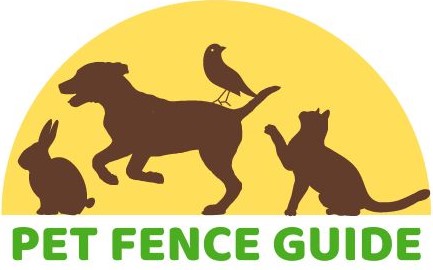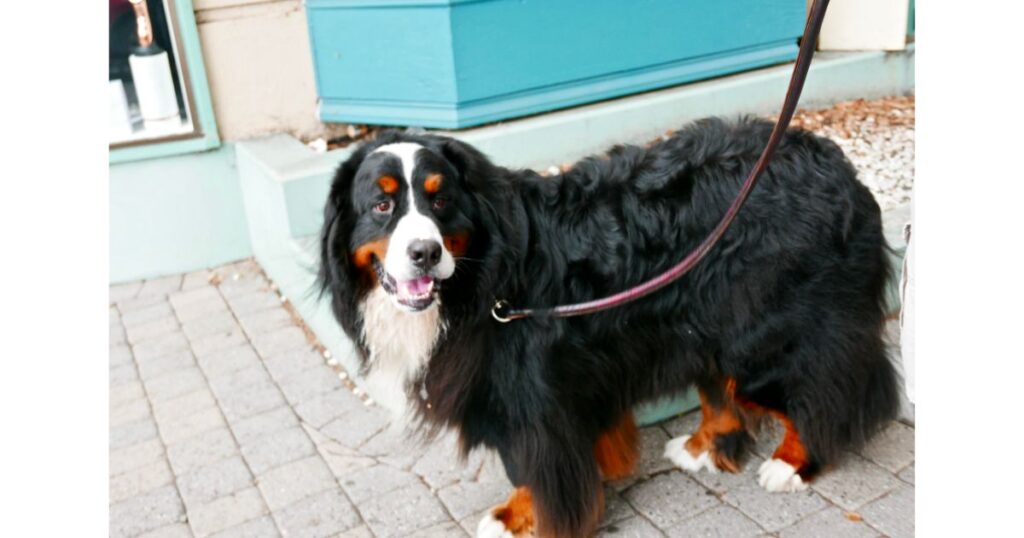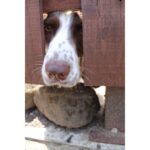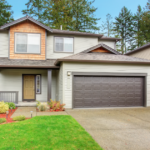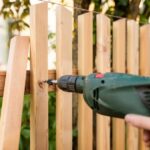When you have a beloved furry friend, ensuring their safety and happiness is a top priority. One essential aspect of responsible dog ownership is creating a secure dog fence area. In this comprehensive guide, we’ll walk you through everything you need to know to establish a safe and inviting space for your four-legged companion. From choosing the right type of fence to maintaining it, we’ve got you covered.
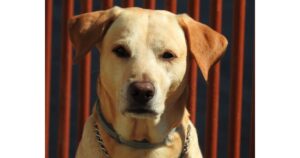
Types of Dog Fence Areas
Table of Contents
ToggleTraditional Fences
Traditional fences have long been a popular choice among dog owners for creating a secure dog fence area. They come in various materials, each with its unique characteristics, and choosing the right one largely depends on your specific needs and preferences.
Wood Fences
Wooden fences are timeless and beloved for their classic and aesthetically pleasing appearance. They offer a sense of privacy and enclosure that both you and your dog will appreciate. When you build a wooden dog fence area, it can blend seamlessly with your home’s architecture, creating a charming backdrop for your pet’s outdoor adventures.
Advantages of Wood Fences:
- Aesthetic Appeal: Wooden fences add a touch of elegance to your outdoor space and can enhance the overall look of your property.
- Privacy: These fences offer a high level of privacy, creating a cozy and secluded environment for your dog to enjoy.
- Customization: Wood fences can be customized in terms of design and height to meet your specific needs.
- Durability: Treated wood can withstand the elements and maintain its structural integrity over time.
Chain-link Fences
Chain-link fences are a practical and budget-friendly option for dog owners. They are durable, cost-effective, and provide excellent visibility, making them a preferred choice for many.
Advantages of Chain-link Fences:
- Visibility: Chain-link fences offer an unobstructed view of your dog, allowing you to keep an eye on them easily.
- Durability: They are highly resilient and can withstand wear and tear, making them a great choice for active dogs.
- Security: These fences provide excellent security, preventing your dog from wandering outside the designated area.
- Low Maintenance: Chain-link fences require minimal maintenance, reducing the time and effort you need to invest.
Vinyl Fences
Vinyl fences have gained popularity in recent years due to their low-maintenance nature and versatility. They are known for their longevity, making them a smart choice for dog owners who prefer a fence that retains its beauty over time.
Advantages of Vinyl Fences:
- Low Maintenance: Vinyl fences are incredibly easy to care for. They resist staining, making cleaning a breeze.
- Longevity: These fences are designed to last for many years, providing an enduring solution for your dog fence area.
- Versatility: Vinyl fences come in various styles and colors, allowing you to select a design that complements your home’s aesthetics.
- Weather Resistance: Vinyl can withstand different weather conditions, ensuring it remains attractive and functional.
Invisible/Electronic Dog Fences
Invisible or electronic dog fences represent a modern and innovative approach to dog containment. They are perfect for homeowners who want to establish boundaries for their pets without obstructing their view of the surrounding landscape.
These systems work by utilizing a collar worn by your dog, which communicates with a transmitter connected to a boundary wire buried in the ground. The collar emits a warning signal or mild correction when your pet approaches the predefined boundary.
Advantages of Invisible/Electronic Dog Fences:
- Unobstructed Views: One of the key benefits is that they don’t interfere with the aesthetics of your outdoor space. You can maintain a clear line of sight and enjoy an unobstructed view.
- Cost-Effective: Invisible fences are often more budget-friendly than traditional fences, especially if you have a large area to cover.
- Customizable Boundaries: You can easily customize the boundaries of the dog fence area, adapting it to your specific yard layout.
- Effective Training: Properly training your dog to respond to the warning signals ensures a secure containment system.
Temporary Dog Fence Solutions
Temporary dog fence solutions offer flexibility and convenience, making them an ideal choice for various situations. They are particularly useful for dog owners with smaller yards, those who travel frequently, or anyone who wants to create a safe environment without committing to a permanent installation.
Playpens
Playpens provide a safe and confined space for your dog to play and exercise. They are easy to set up and can be used both indoors and outdoors. Playpens offer a secure dog fence area within a limited space, allowing your dog to enjoy some outdoor time without wandering.
Portable Fencing
Portable fencing is a versatile solution for dog owners who need flexibility. It’s easy to set up and take down, making it a convenient choice for those who travel or have changing needs. Portable fences are also great for small backyards, where a traditional fence might not be feasible.
Advantages of Temporary Dog Fence Solutions:
- Portability: These solutions are highly portable, allowing you to set up a dog fence area wherever and whenever you need it.
- Convenience: The ease of installation and disassembly makes them a hassle-free choice for dog owners.
- Space Optimization: They are perfect for smaller spaces, enabling you to make the most of your available area.
- Versatility: Playpens and portable fencing can be used both indoors and outdoors, providing flexibility in how you use them.
In summary, when choosing a fence for your dog, consider your specific requirements, budget, and the size of your yard. Traditional fences, such as wood, chain-link, and vinyl, provide excellent durability and aesthetic options. Meanwhile, invisible/electronic fences offer a modern solution with unobstructed views, and temporary fence solutions provide flexibility and convenience, particularly for smaller spaces or those on the go. Each type has its advantages, and selecting the one that aligns with your needs will help create a safe and enjoyable dog fence.
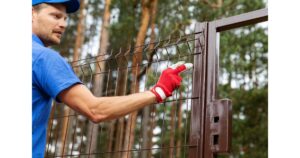
Before you dive into building a dog fence area, take some time to plan. Here are the crucial steps to consider:
Determining the Ideal Location
Choosing the right spot for your dog fence area is essential. Consider your dog’s needs and the layout of your yard. Ensure that there’s enough room for them to play and explore safely. A well-placed dog fence area offers your pet ample space to run and play while allowing you to keep an eye on them.
Measuring the Area
Accurate measurements are key to determining the amount of fencing you’ll need. Take into account the dimensions of your yard and the type of fence you plan to install. Proper measurements help you purchase the right amount of materials and ensure that your dog fence area provides the desired space for your pet.
Local Regulations and Permits
Check your local regulations and secure any necessary permits before installing a dog fence. Compliance with local rules is crucial to avoid legal issues down the road. Before you start building your dog fence area, check with your local authorities to ensure that you adhere to any regulations or permit requirements. This step is essential to prevent any issues or fines in the future.
Budget Considerations
Determine your budget for the project. This will guide your choices in terms of fence type and additional features, such as landscaping. Budget considerations are crucial to ensuring that you complete your dog fence area project within your financial means. It’s important to strike a balance between the features you want and what you can afford.
Building a Traditional Dog Fence
Materials and Tools Needed
For a traditional fence, you’ll need materials such as fence panels or posts, concrete, and the appropriate tools, including a level, shovel, and post hole digger. The materials and tools required for your traditional dog fence area depend on the type of fence you choose. For instance, a wooden fence would require wooden posts, panels, and the appropriate fasteners. Be sure to gather all the necessary materials and tools before you begin.
Step-by-Step Installation Guide
- Start by marking the fence’s layout with stakes. Properly marking the layout ensures that your dog fence area is accurately defined.
- Dig post holes at regular intervals and insert posts. The spacing between posts is crucial for the fence’s stability.
- Secure the posts with concrete. Concrete helps anchor the posts and prevents them from shifting.
- Attach fence panels. Carefully follow the manufacturer’s instructions to ensure a secure and attractive installation.
- Install gates and locks for easy access. Gates provide convenient entry and exit points for both you and your dog.
Maintenance and Repairs
Regular maintenance ensures your fence stays in good shape. Inspect it for loose boards, rust, or other damage. Repair any issues promptly to keep your dog safe and secure. Maintenance of your traditional dog fence area is essential to ensure its longevity. Regular inspections help identify and address issues early, preventing more significant problems later on.
Installing an Invisible/Electronic Dog Fence
How It Works
Invisible dog fences operate on a simple principle. Your dog wears a collar with a receiver that communicates with a transmitter connected to a boundary wire buried in the ground. The invisible dog fence area relies on a boundary wire to establish the perimeter. When your dog approaches this boundary, the collar emits a warning signal, and if your pet persists, it delivers a mild correction.
Setting Up the System
- Install the transmitter and set the boundary limits. The transmitter is typically located in a dry, protected area.
- Fit the receiver collar properly on your dog. The collar should fit snugly but not too tight.
- Train your dog to respond to the warning signals and corrections. Proper training is essential to ensure your dog understands the boundaries.
- Regularly check the collar and boundary for maintenance. Regular checks help ensure the system functions correctly, providing a secure dog fence area.
Pros and Cons
Invisible dog fences offer benefits like unobstructed views and cost-effectiveness, but they also require training and may not be suitable for all dogs. While invisible dog fences offer advantages, it’s important to consider their limitations. Some dogs may not respond well to the correction provided by the collar, and ongoing training is essential for their effectiveness.
Temporary Dog Fence Solutions
Benefits of Temporary Options
Temporary solutions like playpens and portable fencing provide flexibility and are ideal for short-term use or for smaller yards. Temporary dog fence areas offer several advantages. They are easily adjustable, portable, and cost-effective, making them suitable for various situations.
Choosing the Right One for Your Needs
Consider the size and temperament of your dog, as well as the intended use of the fence when selecting a temporary solution. The choice of a temporary dog fence area should align with your pet’s needs. For active dogs, a spacious playpen is ideal, while smaller, portable fences can be used for puppies or small dogs.
Setting Up and Storing Temporary Fences
These fences are typically easy to set up and take down. Store them properly to prolong their lifespan. Portable dog fences are designed for quick and straightforward assembly. When not in use, store them in a dry, cool place to prevent damage.
Landscaping Your Dog Fence Area
Create an inviting and safe environment for your dog with thoughtful landscaping.
Dog-Friendly Plants
Include plants like lavender, sunflowers, and blueberry bushes that are safe for your dog and can enhance the aesthetics of your fence area. Dog-friendly plants not only add beauty but also create a safe and enjoyable environment for your pet.
Avoiding Toxic Plants
Be aware of toxic plants such as azaleas, oleander, and foxglove, which can harm your dog if ingested. Knowing which plants to avoid is crucial to protect your pet from potential dangers in the dog fence area.
Creating a Comfortable Environment
Consider shade, water sources, and outdoor dog-friendly furniture to make your dog’s space comfortable and appealing. Adding comfortable features to your dog fence area, like shade and water sources, creates an environment where your dog can relax and enjoy the outdoors.
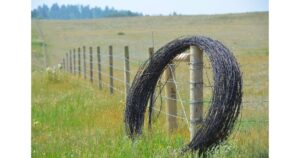
Safety Measures for Dog Fence Areas
Ensuring your dog’s safety is paramount when creating a dog fence area.
Gates and Locks
Install secure gates with locks to control access to and from the area. Sturdy gates with reliable locks prevent accidental escapes and unauthorized entry.
Supervision and Monitoring
Always supervise your dog when they’re in the fenced area and use security cameras if needed. Close supervision and monitoring are essential, especially for puppies and young dogs.
Preventing Digging and Jumping
Reinforce the fence to prevent digging under or jumping over it. Digging prevention measures, such as burying wire mesh, can deter escape attempts.
Avoiding Common Hazards
Eliminate potential hazards like sharp objects or toxic substances within the fenced area. A safe dog fence area should be free from any hazards that could harm your pet.
Maintaining Your Dog Fence Area
Regular upkeep keeps your dog’s environment safe and appealing.
Regular Inspections
Inspect the fence for wear and tear, loose components, or signs of damage. Frequent inspections help you identify and address issues promptly.
Cleaning and Repairs
Clean the fence as needed, and repair any damage promptly. Cleaning and repairs are part of routine maintenance to keep your dog fence area in top condition.
Upgrading and Enhancing
Consider upgrades like additional gates or improved landscaping to enhance the area. Upgrades provide opportunities to enhance your dog’s environment and address changing needs.
Dog Fence Area for Specific Needs
Different situations may require tailored solutions.
Large Dogs
For larger breeds, choose sturdy materials and provide ample space for them to move around. Large dogs require a dog fence area with sturdy construction and enough space for them to move comfortably.
Multiple Dogs
If you have multiple dogs, ensure there’s enough room for them to coexist peacefully. A spacious dog fence area can accommodate multiple dogs while providing ample space for each pet.
Small Yards
In smaller yards, opt for space-saving fence designs and utilize vertical space. Small yards may require creative solutions, such as vertical gardens and compact fence designs.
Special Requirements (e.g., Escape Artists)
Address specific needs, such as preventing digging or escaping, with additional measures. Escape-proofing measures are crucial if your dog has a history of attempting to escape.
Conclusion
Creating a safe and secure dog fence area is a vital step in being a responsible pet owner. By selecting the right type of fence, planning carefully, maintaining it well, and considering your dog’s unique needs, you can provide a happy and protected environment for your furry friend. Remember, a safe dog is a happy dog!
